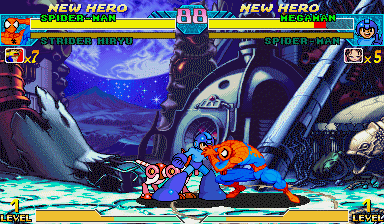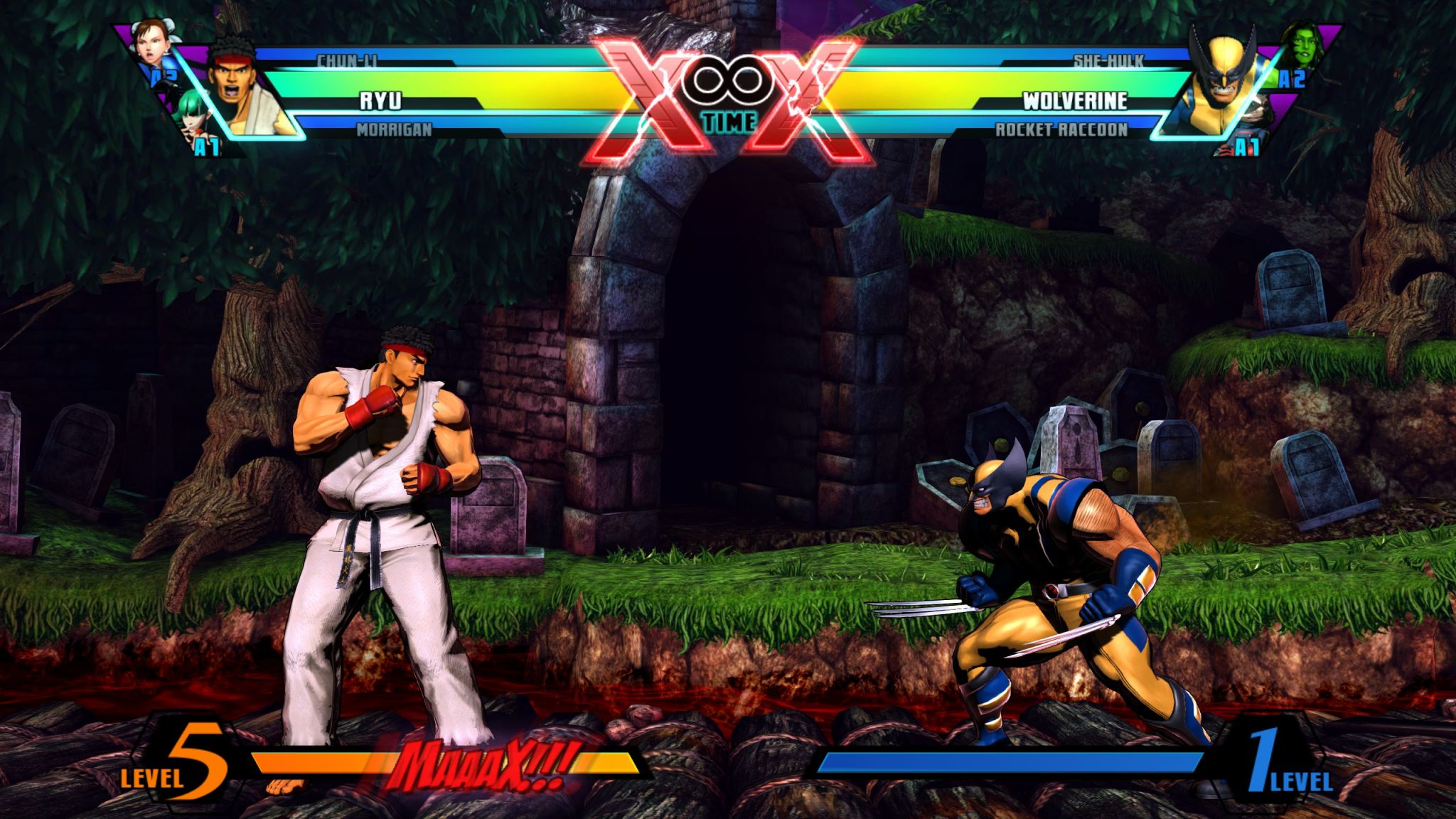
In 1996, near the end of the Golden Age of arcade fighting games, Capcom released X-Men vs Street Fighter. Featuring 17 characters taken from both the Street Fighter and X-Men universe, the game was like a schoolyard argument come to life: "Who would win in a fight, Akuma or Wolverine?" The Street Fighter formula was tweaked to include tag-team character battles, super jumps, over-the-top full-screen effects and super moves, and ridiculously drawn-out combos both on the ground and in the air. If you liked your Street Fighter turned up to eleven, this was your jam.
The game was bright, loud, and frantic, like a cartoon come to life. That was appropriate, as the X-Men characters were modeled after the animated series, right down to the voice actors used for the game. The sprites were large (for the time), colorful and well drawn, and beautifully animated, bringing the two worlds together in a way that felt utterly natural.

The newly released Marvel vs. Capcom: Infinite feels just as ridiculous as the original did more than two decades ago. The combos are over the top, the supers are huge and flashy, and there are more particle effects flying around at any given moment than you can count. Lab monsters who love spending time in training mode finding new combos and setups will find they have more than ever to work with; the creative options are wide open.
This time around, the game ties neatly into the big Marvel Cinematic Universe, with the option to choose an Infinity Stone for each battle to give extra abilities to play with. It's a great way to connect the films to the game, but it's also the first sign that this game is coming from a very different direction than its predecessors. That change is especially apparent in the game's art style, which has an uncanny valley realism that just doesn't mesh well with the characters' more cartoony and pixellated origins. This isn't Comic Book Marvel any more, this is Movie Marvel.
A brief history of the Versus series
After the 1996 original, Capcom continued the Versus series, next with Marvel vs. Capcom: Clash of Super Heroes. Characters like Venom, The Hulk, and Spider-Man rounded out the Marvel side, while the Capcom side gained fan favorites like Mega Man, Strider, and Morrigan from the Dark Stalkers series (also known as Vampire Savior in Japan). Once again, thanks to the talented sprite artists, the two universes felt right together. Comic books and video games, it was like queso and chips—you practically couldn't miss.
2000's Marvel vs. Capcom 2: New Age of Heroes would expand the roster to 56 characters. The screen resolution also saw a bump thanks to the Sega Naomi hardware the game runs on, perhaps more familiar to home console fans as a juiced-up Dreamcast. (There's a reason the Dreamcast got so many practically arcade-perfect ports!) Only the backgrounds took advantage of the new resolution, however, as many of the sprites were reused from the older, lower-resolution games. Even upscaled they still looked great, with the added benefit of being even more crisp and clear, albeit looking a bit more pixellated. The newly added characters used the old art style, so time-traveling mutant Cable versus Resident Evil's Jill Valentine still looked right.

Then came the dark ages of Capcom fighters. The arcades were dying, business realities shifted, and the company stopped making new fighting games for years.
After over a decade of no new Versus titles, Marvel vs. Capcom 3: Fate of Two Worlds dropped in 2011. The pixel art era was over. This was the first 3D entry in the series, and, while the models weren't exactly cutting edge, they had a comic-book like quality that hid their deficiencies well and served to make the various character styles still feel cohesive. This was complimented by a large comic-booky font and an overall comic-book aesthetic, so the character selection screen even looked like the paper pages. The over-the-top combos and supers continued to get even more ridiculous, and the video game vs comic book style still felt natural even in 3D.
A failure to merge
The main problem with Marvel vs. Capcom Infinite is an adherence to a "live action" look that just doesn't mesh with Capcom's video game universe. It's like someone stole your queso and substituted vegan cottage cheese. Yeah, you can put it on chips, but it's not the same. Mega Man and Arthur from Ghost n' Goblins fall directly into the creepiness of the uncanny valley when put next to Hawkeye and his bro'd-out purple sunglasses.
The comic book-style shading that helped meld the two universes is gone, and the textures are all oddly uniform and lit too evenly. This makes "human" skin, "video game" skin, and just about every other texture look oddly similar. The humans don't quite feel real, the video game characters don't quite feel fake enough, and it's just a bit off-putting for a series that once defined the peak of style.
It's enough to make you pine for the days of sprites and pixel art, when every frame was hand-drawn, and different worlds could be brought together with style and attention to line work and colors. It's the same reason the cinematic X-Men wear bulky black leather armor instead of skin-tight yellow and blue tights. Some things just don't look right in the "real world" style; it takes a drawing to bring some costumes to life properly.
Bringing the movies home
Speaking of the X-Men, that's one more place the emphasis on movies over comic books hurts the game. There are no X-Men, no iconic Magneto, and no series-favorite Dr. Doom. Those are all Fox properties in the film world, and while Marvel owns the game rights to all those characters, the company apparently doesn't care to feature characters that advertise for a rival movie studio. The series feels oddly disconnected without these standards.

Instead we get a roster that feels targeted at a new generation drawn to Marvel through the power of a decade of cinematic success. That means lots of Avengers, Guardians of the Galaxy characters, and Spider-Man (since Sony cut a deal to do some universe sharing on the silver screen). It's not a particularly inspired cast, there aren't any surprises, and the lack of fan favorites makes the choices harder to take. With the Black Panther movie over the horizon, be prepared for inevitable Black Panther DLC in the first wave of paid upgrades. We can only hope Marvel's and Capcom's love of money leads to the X-Men eventually being added as DLC in the future.
But how does it play?
Graphical issues aside, Marvel vs. Capcom Infinite still feels like a Marvel vs Capcom game. High-level competition is going to be ridiculous to watch, with the usual screens full of constant manic motion. Spending time in training mode optimizing your combos and resets, choosing a complimentary team, and learning to use the various Infinity Stones will keep hardcore fighting game fans busy for a long while.
If you're a more casual player, there is single-player content, but be warned that it isn't very deep. Capcom did at least learn its lesson from the poor launch of Street Fighter V, which featured almost nothing for solo players to do. There's a basic arcade mode where you can pick your team and battle your way through successive enemy teams to fight the big boss (I won't spoil how that works, but the final fight is a bit different from a normal one). It's a perfectly serviceable way to play against computer-controlled opponents and start to learn the game, but don't expect any real story flair or extras.
As with most fighting games, the creativity of the matches will never shine that hard without human opponents. There are some basic tutorials and easy-mode combos that will get you out of the gate, but serious play against skilled players is going to require practice and lab time. If you don't have human opponents nearby, the online netcode seems better than Marvel vs. Capcom 3 at first glance, but it's hard to judge it until the general public is logged in and playing.
There's a story mode where you watch the aforementioned iffy 3D models mouth their way through a plot that seems to mostly exist for the characters to call out each other's names, as if to confirm that yes, the Marvel and Capcom characters do inhabit the same world. The voice acting is corny, but there's a charming campiness in there. Rocket Raccoon making jokes about how many people Mega Man has killed with his Mega Buster or asking Dante from Devil May Cry if he can borrow his guns might bring a grin to your face the first few times you hear them.
If you're looking for a superhero game with a well-animated and well-acted story, the DC comics-themed Injustice 2 does what Capcom is trying to do much better. For everyone else, Marvel vs Capcom: Infinite is great fun in both arcade mode and for challenging local friends (not to mention losing to online strangers who've probably been practicing more than you).It's just a pity the magic that Capcom captured in the '90s with their hand-drawn sprites has been lost to generic, plasticky 3D models. The game is fun, but that world-mashing graphical charm just isn't the same.

Reader Comments (55)
View comments on forumLoading comments...